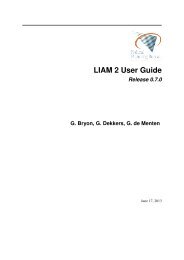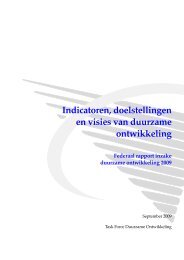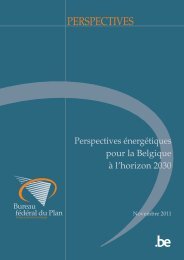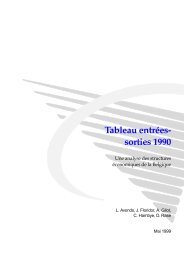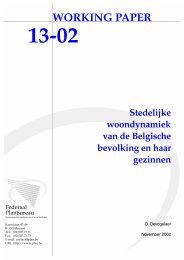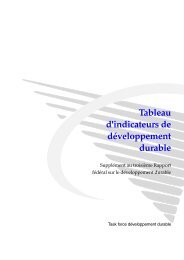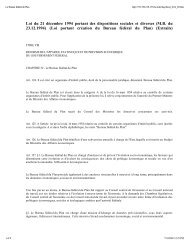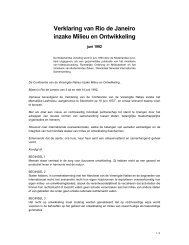long-term care use and supply in europe: projections for germany ...
long-term care use and supply in europe: projections for germany ...
long-term care use and supply in europe: projections for germany ...
You also want an ePaper? Increase the reach of your titles
YUMPU automatically turns print PDFs into web optimized ePapers that Google loves.
LONG-TERM CARE USE AND SUPPLY IN EUROPE | 37<br />
BIOL: The ‘biology’ scenario is more optimistic than the DELAY scenario. It assumes a similar relative<br />
disability <strong>in</strong>cidence decl<strong>in</strong>e as the mortality <strong>in</strong>cidence decl<strong>in</strong>e. DELAY assumed a same absolute<br />
decl<strong>in</strong>e (<strong>in</strong> number of life years) <strong>in</strong> disability <strong>and</strong> mortality <strong>in</strong>cidence. BIOL yields higher <strong>in</strong>cidence<br />
decl<strong>in</strong>es at younger age, but lower decl<strong>in</strong>es at older ages, while the reverse holds <strong>for</strong> the DELAY<br />
scenario.<br />
b. Risk factor scenarios<br />
The second set of disability scenarios makes assumptions about trends <strong>in</strong> two important risk factors with<br />
regard to disability: smok<strong>in</strong>g <strong>and</strong> obesity. For all risk factor scenarios, background assumptions on<br />
mortality <strong>and</strong> disability <strong>in</strong>cidence are based on the DELAY scenario.<br />
Smok<strong>in</strong>g<br />
The disability <strong>in</strong>cidence of smokers does not differ much from that of non-smokers (see Bonneux et al.,<br />
2011). A ma<strong>in</strong> ca<strong>use</strong> of disability <strong>in</strong> smokers is chronic obstructive pulmonary disease (COPD), but only<br />
a fraction of smokers is affected by (severe) COPD. As smok<strong>in</strong>g strongly <strong>in</strong>creases the risk of dy<strong>in</strong>g,<br />
there<strong>for</strong>e, all th<strong>in</strong>gs equal, it tends to decrease age-related disability. The scenarios with regard to trends<br />
<strong>in</strong> smok<strong>in</strong>g are the follow<strong>in</strong>g:<br />
SMOK: This scenario projects the (still high) prevalence of smok<strong>in</strong>g of younger cohorts <strong>in</strong>to the future<br />
<strong>and</strong> assumes they will cont<strong>in</strong>ue smok<strong>in</strong>g. This is a ‘worst case’ assumption.<br />
TREND: The ‘TREND’ scenario starts from the ‘SMOK’ scenario but adds the assumption that <strong>in</strong> future<br />
cohorts smokers will successfully quit at a rate of 2% per year. This seems a rather realistic scenario, the<br />
assumption of quitt<strong>in</strong>g be<strong>in</strong>g close to recent observations.<br />
NOSMOK: This scenario modifies the ‘SMOK’ scenario by assum<strong>in</strong>g that none of the future 55 year<br />
olds will be smok<strong>in</strong>g, but rema<strong>in</strong><strong>in</strong>g smokers <strong>in</strong> the older population will cont<strong>in</strong>ue smok<strong>in</strong>g. In this<br />
assumption, the large smok<strong>in</strong>g cohorts will only be ext<strong>in</strong>ct around 2055. In 2040, many smokers still<br />
survive at high age, which can ca<strong>use</strong> paradoxical results <strong>in</strong> the disability <strong>projections</strong>.<br />
NOSQUIT: This scenario adds high quit rates to the ‘NOSMOK’ scenario. It is an extreme ‘no smok<strong>in</strong>g’<br />
scenario, as smokers die or quit <strong>and</strong> are not replaced by new cohorts of smokers. Compared to the<br />
‘TREND’ scenario it projects <strong>in</strong>creased disability, but also decreas<strong>in</strong>g smok<strong>in</strong>g related mortality.<br />
Obesity<br />
With regard to obesity, mortality does not differ much between obese people <strong>and</strong> the non-obese, but<br />
prevalence of disability is higher <strong>for</strong> obese persons (see Bonneux et al., 2011). Obesity ca<strong>use</strong>s wear <strong>and</strong><br />
tear of jo<strong>in</strong>ts of knees, hips <strong>and</strong> back, lead<strong>in</strong>g to loss of mobility. The scenarios with regard to trends <strong>in</strong><br />
obesity are the follow<strong>in</strong>g:<br />
BMI: This scenario assumes an <strong>in</strong>creased prevalence of obesity <strong>in</strong> <strong>in</strong>flow<strong>in</strong>g future cohorts of older<br />
persons. These prevalences are kept constant over the projection period.<br />
LEAN: The ‘lean’ scenario is an extremely optimistic scenario. It halves the prevalence of obesity <strong>for</strong> all<br />
<strong>in</strong>flow<strong>in</strong>g future cohorts of 55 year old.<br />
FAT: This is an extremely pessimistic scenario. It assumes that the prevalence of obesity <strong>for</strong> all<br />
<strong>in</strong>flow<strong>in</strong>g future cohorts of 55 year old is doubl<strong>in</strong>g.<br />
4.2.3 Chang<strong>in</strong>g ho<strong>use</strong>hold composition scenario<br />
The ho<strong>use</strong>hold composition of older persons is chang<strong>in</strong>g <strong>in</strong> many European countries, as widowhood is<br />
postponed to higher ages, divorce rates are <strong>in</strong>creas<strong>in</strong>g <strong>and</strong> co-residence rates of older parents <strong>and</strong><br />
children are decreas<strong>in</strong>g (Bernard, 2000; Herce, 2003; Lowenste<strong>in</strong>, 1999). The ‘chang<strong>in</strong>g ho<strong>use</strong>hold<br />
composition’ scenario (DELAY HH) takes account of future trends <strong>in</strong> ho<strong>use</strong>hold composition of the<br />
older population, based on exist<strong>in</strong>g <strong>projections</strong> of ho<strong>use</strong>hold composition (see 4.2). There<strong>for</strong>e, <strong>for</strong> each



